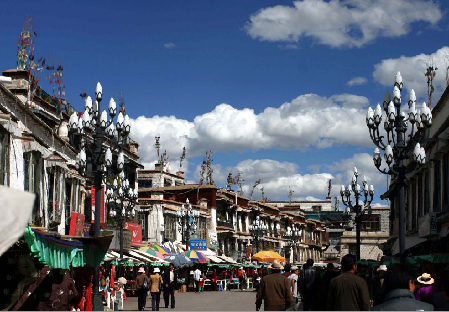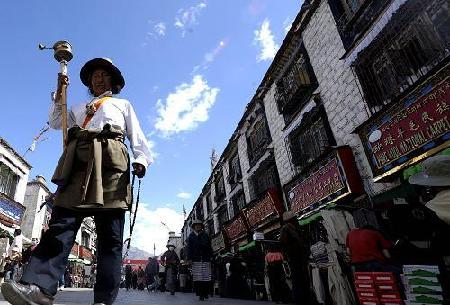|

Traditional lifestyles are maintained in the center of the old city -- Lhasa. Rich and colorful ethnic handicrafts are available that you won't find anywhere else.
No one can claim to have really visited Lhasa until they have taken a stroll around Barkhor Street. Famous in Lhasa, and throughout the entire Tibetan Autonomous Region, Barkhor Street is a trading site as well as religious center. As the oldest street in Lhasa, Barkhor is circular and still remains quite traditional.
The street is narrow and lined with stalls or shops on each side. Goods for sale are typical reflections of Tibetan culture. From morning to evening, streams of people throng in to purchase whatever they need.

Barkhor is a marketplace where shaggy nomads, traders, robed monks and chanting pilgrims are together, mixing in shops and stalls. On sale are printed scriptures, cloth prayer flags and other religious items, jewelry, Tibetan knives, and ancient coins, and more.
Barkhor is also the sacred pilgrimage site. It is a place where Tibetan culture, economy, religion and arts assemble. It was said that in the seventh century Songtsen Gampo, the first Tibetan King who unified Tibet, chose the site to marry Chinese Princess Wencheng and Nepal Princess Tritsun. Later, the Jokhang Temple was built to accommodate the Jowo Sakyamuni, aged 12, brought to Tibet by Princess Wencheng.
Barkhor is the road pilgrims tramped out around the Jokhang Temple through the centuries. Buddhist pilgrims walk or progress by body-lengths along the street clockwise every day into deep night. Careful visitors may find there are four columns on which colorful scripture streamers are hung flying over the street. All pilgrims walk outside of them to show respect.
The custom started in the Tubo period (633-877). To the west of the north street of Barkhor there is a juniper hearth. A ceremony is held there annually to hail Maitreya (Buddha of the Future). Tibetans also pray before the hearth to seek good fortune in the next year. A yamun, which used to be the office of Lhasa magistrates, squats nearby.

A small lane northward nearby leads to a market, which has longest history in Lhasa. There is a three-story temple was set up in the Tubo period, and its pantheon still remains in the Tubo style after many renovations. It was said that Tibetan characters were invented in the temple.
When strolling around Barkhor Street, a strict rule should be observed. This is to circumnavigate the Jokhang Monastery in a clockwise direction. Each rotation is equivalent to reciting a mantra, which brings with it longevity and an auspicious re-birth.
In the past 30 years many more services and facilities have opened, shops have increased and the street has been scattered with stalls. It bustles with activity and is always jam-packed with trade people. It is a "must" for souvenir-hunting tourists. People call the Barkhor "the window of Tibet," since it is a typical reflection of Tibetan life. It is a magical place, full of the mystery and wonder that is associated with the amazing area.
Best time to go: Summer
|
